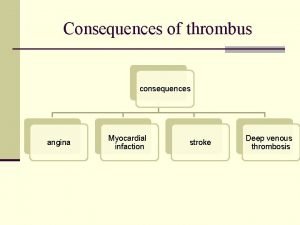The Consequences of Inadequately Integrated Information Systems The
















- Slides: 16

The Consequences of Inadequately Integrated Information Systems: The Case for Crime Reduction Through Integration Dr. Peter Scharf Executive Director Center for Society, Law and Justice University of New Orleans

Why should local, state, and the federal government invest in integrated systems? • It makes records management more efficient and cost effective; • Allows for semi real-time access to criminal histories, status and offense data; • Allows for more grounded decision-making related to decisions regarding persons who are entered into the criminal justice system; • Enhances crime control initiatives.

What is the relationship between investment and integration and crime? • Crime rates, investment in CJ IT and correctional populations have increased over past 30 years. • Correctional populations have continued to increase as crime rates have leveled out. • Pontell (l 980; l 997) argues that availability to case processing resources is critical variable in prosecution of a crime.

“Ideological” debate on what to make of crime rates (and IT) Deterrence, Incapacitation View: • Chance of a Burglary subject going to prison is about 3%. • Costs of uncaught criminals are high: example, un-apprehended murderer may cost society 1 million + over a three year period. • • Consequences for Specific and General Deterrence and Incapacitation. “Broken Windows: ” anomie. Social Consequence: • Crime is primarily a function of social cohesion, labor dynamics -increased arrests may cause disruptions leading to further crime. • Consequential costs of “jacket build up” and corrections can disrupt social programs likely to reduce crime rates. • Labeling consequences may lead to racial disparities and digital underclass.

Exemplars of Issue: South Louisiana Serial Killer Case: Derrick Todd Lee South Louisiana Serial Murder Case History: • • • From 6 to 15+ women killed in South Louisiana 65 unsolved females murders in Baton Rouge since l 990 Pattern may have begun in l 992 -Warner Killings 3 months apart beginning in late 2001 Task Force Registered 18, 000 subjects, 800 DNA “Swabs” Criminal History Markers Related to Derrick Todd Lee: • • • 18 Peeping Tom complaints 6 Burglary arrests 3 assaults Prime Subject in Randi Mebreur case Identification in hatchet assault Identification in rape case


How Lee Avoided Detection • Lack of integration/exchange between Baton Rouge and smaller jurisdictions • Manual triage of leads • Profiling “bias” • Excessive number of leads • Lack of computer skills among investigators • Divisions among investigators • Poor baseline investigations: GIGO • Politics, Politics • GOYAKOD vs. CSI

Criminal Rap Sheet Highlights: Lee As Lee grew older his "rap sheet" became more extensive, including arrests for attempted first-degree murder, stalking, peeping into homes, as well as break in and burglary, among other crimes. Lee's arrests and related incidents between 1992 and 2001 were as follows: • November 1992: Lee arrested for illegal entry and burglary of Zachary residence. • January 1993: Lee and an accomplice, Thomas Whitaker Jr. were arrested for breaking into the home of a 73 -year old man, whom they beat with a stick and robbed. • July 1993: Lee sentenced to one year in prison for burglary. • September 1995: Lee arrested for a peeping incident and resisting arrest, after being chased and caught by police after looking into a woman’s window. During the same month, Lee was arrested again for stealing from a Salvation Army Thrift Store. • August 1997: Lee arrested after being caught looking into a woman’s window. • August 1999: Lee arrested after being caught in a woman's residence uninvited, for being a Peeping Tom and stalking. • December 1999: Received a suspended sentence on a misdemeanor stalking charge • January 2000: Accused of attempted first-degree murder after severely kicking and stomping his girlfriend at a bar after an argument over Lee's advances towards another woman. While trying to flee from the police following the incident he allegedly tried to run over the sheriff's deputy with a car. Lee was sentenced to two years for the incident. • September 2001: Lee arrested for battery of wife but charges later dismissed.

Questions and Quandaries re: Identification of Derrick Todd Lee • Was information regarding Lee available in any system prior to the killings of Green, Pace or Kinamore (July 12, 2002)? • Was information available in “share-able” form? • Was information regarding Lee distinguishable from other repeat offenders? • What human failures were involved in the delay in apprehending Lee? • How might integrated technology be used to assist law enforcement in this type of case?

Research Gap: Consequences Study: Overview • First study aimed at identifying “crimes avertable” through IJIS strategy • Defines key features of an IJIS • Develops taxonomy of “errors” in identification • Provides examples with follow-ups of integration “horror stories” • Limits of study

Summary of Key Features of an IJIS • Accurate identification • Warrants, detainers and restraining orders are available • Criminal histories are complete, accurate and available • Current status and location are accurate and available • Electronic information transfer cues workflow among agencies • Information exchange takes place automatically as a function is performed

Major “error types” in Information Systems • Erroneous Data Input • Improper Release or Failure to Hold • Improper Arrest or Confinement • Risk to Officer from Lack of Information on Offender • Risk to Suspect/Inmate from Lack of Information • Failure to Solve Crimes • Failure to Apprehend • Inappropriate Clearance

Methodological Issues • Strategy • Limits of information about cases • Response tendencies related to embarrassment, liability and politics • Confound of human and technological error

Lessons Learned 1. Cases in which an integrated system might have averted harm are evident: Plethora of cases Varying types of errors Human factors confound 2. Open Questions: Number of incidents are uncertain Costs of “errors” requires additional research Reduction of “harm” through new IJIS strategies is open research question 3. Policy Questions: Fred Friendly “value added” debate Is IJIS investment to reduce costs a viable strategy?

Status of the Issue Can investment in IJIS reduce crime costs ? • Value issues • State of the research • Next step information needed to further the debate • Qualitative changes in strategy/technology • IJIS the “silver” bullet

For Further Dialog and Discussion Center Web Site www. cslj. net CONTACT: Dr. Peter Scharf Executive Director Center for Society, Law and Justice University of New Orleans 3330 North Causeway Boulevard, Suite 413 Metairie, LA 70002 (504) 849 -8021 Plsscharf 24@hotmail. com
 Milkor
Milkor Integrated control safety system
Integrated control safety system Opacdr
Opacdr Integrated systems testing
Integrated systems testing Adams integrated systems
Adams integrated systems Damkt
Damkt Integrated business processes with erp systems
Integrated business processes with erp systems Integrated dispatch systems
Integrated dispatch systems Agriprotien
Agriprotien Ims360
Ims360 Institute for software integrated systems
Institute for software integrated systems St charles integrated care centre
St charles integrated care centre Integrated management systems training north america
Integrated management systems training north america Jaka to roślina
Jaka to roślina Integrated education management system
Integrated education management system Integrated payroll and personnel information system
Integrated payroll and personnel information system Integrated management information system imis
Integrated management information system imis































